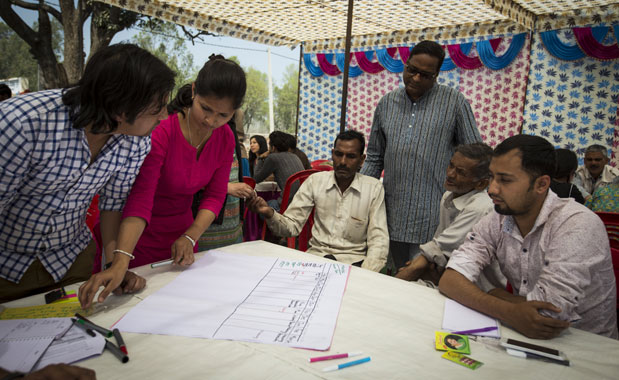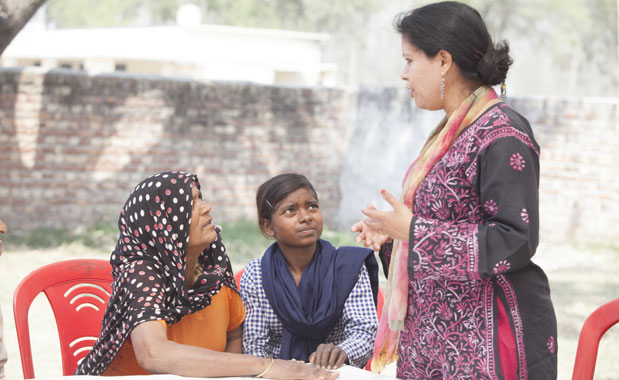By Krity Shrestha, Practical Action
 Stakeholders engage with researchers to discuss the impacts of the changing climate on their lives
Stakeholders engage with researchers to discuss the impacts of the changing climate on their lives
Photo: Jitendra Bajracharya/ICIMOD
Hakimpur Turra is a small village of some 600-700 households in Uttarakhand. More than 60 percent of the villagers are farmers and around 20 percent are daily-wage labourers who work on others’ farms or at industries in Roorkee, the nearby city.
When I visited Hakimpur Turra in early March this year, summer had just begun and the scenery there was picturesque. I got to the village on May 2 along with a team of researchers participating in the HI-AWARE Academy, organised from 27 February–4 March 2016 in New Delhi and Dehradun, India, to strengthen the expertise of its researchers to conduct trans-disciplinary research on climate/social vulnerability, climate stress moments, resilience and adaptation in three river basins in the Hindu Kush Himalayas—the Indus, Ganga and Brahmaputra. The participants had been divided into six groups and led to two villages in Haridwar: Hakimpur Turra and Imlikhera.
On our way to Hakimpur Turra, our group had passed through beautiful landscapes with vast sugarcane fields bordered by tall, lean trees. As researchers and students, we hoped to put to test the climate- and adaptation- related research and assessment techniques we had learnt in New Delhi.
The farmers
 Female stakeholders interact with a researcher in Hakimpur Turra, a village in Uttarakhand
Female stakeholders interact with a researcher in Hakimpur Turra, a village in Uttarakhand
Photo: Jitendra Bajracharya/ICIMOD
As we reached the meeting venue, we saw that the area had been well arranged with tents, Shamiyana as they called it. There was a school nearby, and a temple built for Babasaheb (Dr BR Ambedkar)—the principal architect of the Indian Constitution who inspired the Dalit movement, campaigned against social discrimination against so-called “untouchables” (Dalits), and supported labour rights and the rights of women.
When we began the discussion at our table, we were joined by farmers, all of whom were men. At a place where I’d just seen Babasaheb’s temple, I found that very disappointing. Even when the women joined us, they preferred to sit at a separate table and discuss away from the men. Nevertheless, we began our discussion with a resource map of the village and asked the villagers to identify the water sources, settlements, farms and hazard-prone areas.
Most of our respondents had their own land and planted mostly sugarcanes in their fields, followed by wheat and paddy. Almost all the farmers had also planted poplar tress in and around their fields, which were sold to matchstick factories. Solani, a small river that flowed south of the village, was the only water body in the village, which also provided around one percent of the water for irrigation. Almost all the land comprised of fields; even the village grazing area had been turned into agricultural land and distributed to marginalised Secluded Caste (SC) communities some years ago.
The farmers mostly depended on groundwater (deep boring) for irrigation. They said that the government provided them free electricity—for almost 22 hours a day to facilitate deep boring. They also shared that almost all the houses had pumps for drinking water. The village had communities from different cultures and religions living together in harmony. They complained that they had planted Poplar trees some 15-20 years ago as per the government’s Ped Lagao, Desh Bachao (Plant trees, save the country) campaign only to discover how water-intensive Poplar trees where. They were also disappointed because the poplar trees had not given them as much money as they had expected.
When asked about climate change impacts, a majority of the farmers confirmed that rainfall was more erratic these days, falling in high intensity within short durations. They also talked about dry winters; there was no winter rain this year. The farmers talked about the Uttarakhand floods and about how the Solani River had swelled up and inundated the whole village in 2013. It was interesting, how they blamed it all on fish farming in the Solani River; they said that whenever fish farming was practiced in the Solani , it had always resulted in a flood. The erratic rainfall, apart from flood and inundation, had very little impact on their agriculture, as they deep bore for irrigation. When asked if the floods and disaster affected men and women differently, they simply answered that the impact was the same for both.
The daily-wage labourers
On the second day, March 3, we went to the same place to discuss with the same respondents with the aim of identifying critical climate stress moments for them. However, we were joined by a new group of people, who were mostly daily wage labourers and worked in Roorkee. Interestingly, there were women in our group this time, and they were confident enough to talk and share along with the men in the group. Since it was not possible to continue the discussion from the day before we had to ask them about how they felt and about the challenges they identified for their village. This time, we got very different answers from what we had got the previous day. Since this group was composed dominantly of labourers, the villagers were not concerned about water availability and crop yield. They didn’t have their own fields, which meant what they were really concerned about was floods and disasters. They said that when the river floods, all the roads get inundated as well which means the labourers are unable to get to Roorkee for work. If the flood lasts long, then they have nothing to eat. During floods, the farmers get special relief packages and insurance money from the government, but the labourers are completely ignored. Most of them do not own houses either.
The women talked fearlessly about how they cycle every day to and from Roorkee, and are earning to feed their families. They said that for them, the critical moment was the flooding period as they were unable to work and provide for their family during floods. When we asked if disasters affected men and women differently, all the members in the group confirmed that they did in unison. It was really good to see that the women were participating equally. Most of them didn’t know about climate change, but said that it was getting warmer than in previous years and that there were less rainy days. They also talked about how some of them, along with marginalised SCs, were involved in riverbed farming of vegetables for personal use, as they didn’t own land.
Social differences
The two groups we’d talked to over the course of the two days seemed to complement each other. While the impacts of climate change were obviously visible in the intensity and frequency of temperature and the increase in hot/warm days as perceived by almost all the respondents, it was also clear that there was a big difference in how the landless and land-holding farmers perceived and responded to these changes. The social differences were also visible as the women from the labourer group seemed more outspoken and confident. Even though there were cooperatives reported in the village, many were led by landholding farmers who were directly receiving benefits and not sharing them with landless communities. The same flood which impacted all the villagers left the labourers poorer and more vulnerable than the rest and yet they didn’t have any social security net to help them cope with the flood.
The two-day field visit was helpful in many ways as we were able to implement and learn about various tools and methods in a practical way; much more than we had learnt in preceding HI-AWARE Academy classroom days. However, two days is a short time and we were unable to get a complete picture of the village and of the various challenges the villagers were facing, during our time there.
